TACC3 is essential for EGF-mediated EMT in cervical cancer
- PMID: 23936413
- PMCID: PMC3731346
- DOI: 10.1371/journal.pone.0070353
TACC3 is essential for EGF-mediated EMT in cervical cancer
Erratum in
- PLoS One. 2013;8(9). doi:10.1371/annotation/23c9bde1-5ced-4eb9-8a73-c53f3f2913d4. Breuer, Eun-Kyoung Yim [corrected to Breuer, Eun-Kyoung]
Abstract
The third member of transforming acidic coiled-coil protein (TACC) family, TACC3, has been shown to be an important player in the regulation of centrosome/microtubule dynamics during mitosis and found to be deregulated in a variety of human malignancies. Our previous studies have suggested that TACC3 may be involved in cervical cancer progression and chemoresistance, and its overexpression can induce epithelial-mesenchymal transition (EMT) by activating the phosphatidylinositol 3-kinase (PI3K)/Akt and extracellular signal-regulated protein kinases (ERKs) signal transduction pathways. However, the upstream mechanisms of TACC3-mediated EMT and its functional/clinical importance in human cervical cancer remain elusive. Epidermal growth factor (EGF) has been shown to be a potent inducer of EMT in cervical cancer and associated with tumor invasion and metastasis. In this study, we found that TACC3 is overexpressed in cervical cancer and can be induced upon EGF stimulation. The induction of TACC3 by EGF is dependent on the tyrosine kinase activity of the EGF receptor (EGFR). Intriguingly, depletion of TACC3 abolishes EGF-mediated EMT, suggesting that TACC3 is required for EGF/EGFR-driven EMT process. Moreover, Snail, a key player in EGF-mediated EMT, is found to be correlated with the expression of TACC3 in cervical cancer. Collectively, our study highlights a novel function for TACC3 in EGF-mediated EMT process and suggests that targeting of TACC3 may be an attractive strategy to treat cervical cancers driven by EGF/EGFR signaling pathways.
Conflict of interest statement
Figures
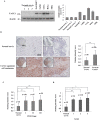
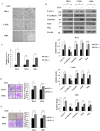
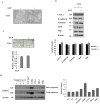
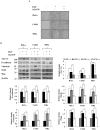
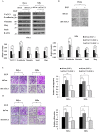

Similar articles
-
TACC3 promotes epithelial-mesenchymal transition (EMT) through the activation of PI3K/Akt and ERK signaling pathways.Cancer Lett. 2013 May 10;332(1):63-73. doi: 10.1016/j.canlet.2013.01.013. Epub 2013 Jan 21. Cancer Lett. 2013. PMID: 23348690
-
Snail regulated by PKC/GSK-3β pathway is crucial for EGF-induced epithelial-mesenchymal transition (EMT) of cancer cells.Cell Tissue Res. 2014 Nov;358(2):491-502. doi: 10.1007/s00441-014-1953-2. Epub 2014 Aug 16. Cell Tissue Res. 2014. PMID: 25124796
-
Epithelial-mesenchymal transition in cervical cancer: correlation with tumor progression, epidermal growth factor receptor overexpression, and snail up-regulation.Clin Cancer Res. 2008 Aug 1;14(15):4743-50. doi: 10.1158/1078-0432.CCR-08-0234. Clin Cancer Res. 2008. PMID: 18676743
-
EGF-receptor signaling and epithelial-mesenchymal transition in human carcinomas.Front Biosci (Schol Ed). 2012 Jan 1;4(2):671-84. doi: 10.2741/s292. Front Biosci (Schol Ed). 2012. PMID: 22202084 Review.
-
TACC3: a multi-functional protein promoting cancer cell survival and aggressiveness.Cell Cycle. 2023 Dec-Dec;22(23-24):2637-2655. doi: 10.1080/15384101.2024.2302243. Epub 2024 Jan 10. Cell Cycle. 2023. PMID: 38197196 Free PMC article. Review.
Cited by
-
Identification of SEC62 as a potential marker for 3q amplification and cellular migration in dysplastic cervical lesions.BMC Cancer. 2016 Aug 23;16(1):676. doi: 10.1186/s12885-016-2739-6. BMC Cancer. 2016. PMID: 27553742 Free PMC article.
-
Placenta growth factor promotes migration through regulating epithelial-mesenchymal transition-related protein expression in cervical cancer.Int J Clin Exp Pathol. 2014 Dec 1;7(12):8506-19. eCollection 2014. Int J Clin Exp Pathol. 2014. PMID: 25674215 Free PMC article.
-
Epidermal Growth Factor Receptor and Transforming Growth Factor β Signaling Pathways Cooperate To Mediate Chlamydia Pathogenesis.Infect Immun. 2020 Mar 23;88(4):e00819-19. doi: 10.1128/IAI.00819-19. Print 2020 Mar 23. Infect Immun. 2020. PMID: 31964750 Free PMC article.
-
TACC3 as an independent prognostic marker for solid tumors: a systematic review and meta-analysis.Oncotarget. 2017 Aug 24;8(43):75516-75527. doi: 10.18632/oncotarget.20466. eCollection 2017 Sep 26. Oncotarget. 2017. PMID: 29088887 Free PMC article.
-
Pretreatment TACC3 expression in locally advanced rectal cancer decreases the response to neoadjuvant chemoradiotherapy.Aging (Albany NY). 2018 Oct 19;10(10):2755-2771. doi: 10.18632/aging.101585. Aging (Albany NY). 2018. PMID: 30341253 Free PMC article.
References
-
- Huber MA, Kraut N, Beug H (2005) Molecular requirements for epithelial-mesenchymal transition during tumor progression. Curr Opin Cell Biol 17: 548–558. - PubMed
-
- Thiery JP, Acloque H, Huang RY, Nieto MA (2009) Epithelial-mesenchymal transitions in development and disease. Cell 139: 871–890. - PubMed
-
- Tanos B, Rodriguez-Boulan E (2008) The epithelial polarity program: machineries involved and their hijacking by cancer. Oncogene 27: 6939–6957. - PubMed
MeSH terms
Substances
LinkOut - more resources
Full Text Sources
Other Literature Sources
Medical
Research Materials
Miscellaneous

